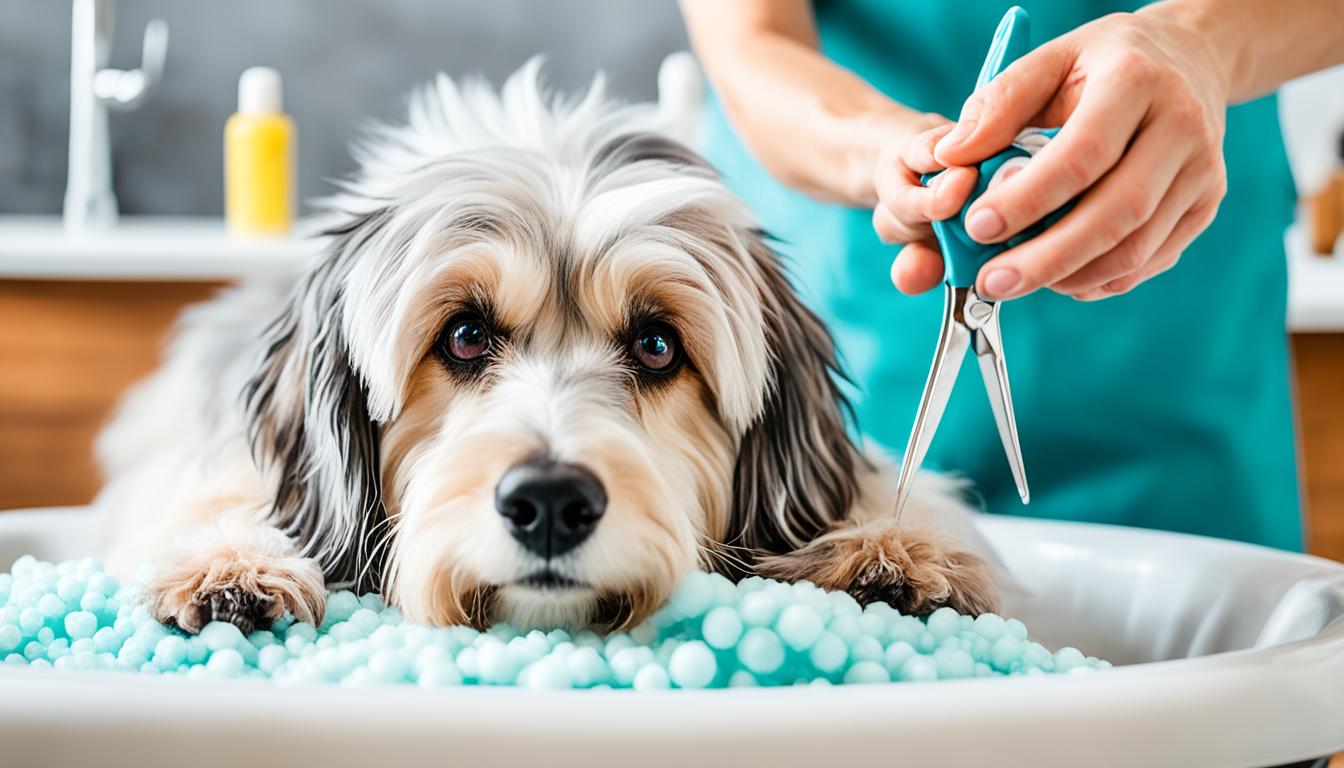In this article, we will explore the world of DIY pet grooming and learn quick and effective techniques that you can easily do at home. Taking care of your pet’s grooming needs not only keeps them looking their best but also promotes their overall health and well-being. Whether you have a dog, a cat, or any other furry friend, grooming them at home can be a rewarding and fulfilling experience.
From understanding DIY pet grooming techniques to essential grooming supplies, we will cover a wide range of topics that will empower you to confidently groom your pet at home. We will provide step-by-step guides, grooming tips for pets with specific coat types, and even address common challenges that pet owners may face during grooming sessions. By the end of this article, you’ll have all the knowledge and skills to keep your pet looking great without having to visit a professional groomer.
Key Takeaways:
- DIY pet grooming allows you to save time and money by grooming your pet at home.
- Grooming your pet regularly promotes their overall health and keeps them looking their best.
- Understanding DIY grooming techniques and using the right supplies is essential for successful pet grooming at home.
- Different coat types require specific grooming techniques and care.
- By addressing common challenges and following easy techniques, even busy owners can groom their pets effectively.
Understanding DIY Pet Grooming Techniques
In this section, we will delve into the importance and benefits of understanding DIY pet grooming techniques. By learning how to groom your pet at home, you can save time and money, and also strengthen the bond between you and your furry friend.
Grooming your pet by yourself can be a rewarding experience. Not only does it give you the opportunity to take an active role in your pet’s care, but it also allows you to develop a deeper understanding of their needs and preferences.
One of the most basic DIY pet grooming techniques is brushing. Regular brushing helps remove loose hair, prevents matting, and stimulates the skin for a healthier coat. It also provides an opportunity for you to check your pet’s skin and detect any abnormalities or pests.
Trimming your pet’s nails is another crucial aspect of DIY grooming. Overgrown nails can lead to discomfort and even health issues in pets. Learning how to trim their nails safely and correctly will contribute to their overall well-being.
“By taking the time to learn DIY pet grooming techniques, you can provide your pet with the care they deserve while creating a stronger bond and saving money.”
Regular grooming has numerous benefits for your pet’s health. It can help prevent skin irritations and infections, enhance circulation, and keep their coat in optimal condition.
To further understand the importance of DIY pet grooming, let’s take a look at the potential cost savings. Professional grooming services can be expensive, especially when done regularly. By learning DIY techniques, you can significantly reduce these costs and allocate the savings to other aspects of your pet’s well-being.
In conclusion, understanding DIY pet grooming techniques not only benefits your pet’s health and appearance but also strengthens the bond between you and your furry companion. By taking an active role in their grooming routine, you can ensure their well-being while enjoying a cost-effective and engaging experience.
Essential DIY Pet Grooming Supplies
In this section, we will discuss the essential DIY pet grooming supplies that you will need to successfully groom your pet at home. Grooming your pet is an important part of their overall health and well-being, and having the right supplies can make the process easier and more effective.
Grooming Brushes and Combs
The first essential item for grooming your pet at home is a good-quality brush or comb. These tools are essential for removing loose hair, tangles, and mats from your pet’s coat. Different breeds and coat types require specific brushes and combs, so it’s important to choose the right one for your pet. For example:
- A slicker brush is ideal for removing loose hair and tangles in long-haired breeds.
- A bristle brush is suitable for breeds with short hair and helps distribute natural oils for a healthy coat.
- A pin brush is useful for breeds with curly or wiry coats.
- A comb with both wide and narrow teeth is perfect for removing mats and tangles.
Grooming Clippers
If you plan on giving your pet a haircut, investing in a good pair of grooming clippers is essential. Clippers designed specifically for pets are lightweight, quiet, and equipped with different blade sizes to suit various coat lengths. They make it easier to trim your pet’s hair safely and efficiently.
Natural Shampoos and Conditioners
Using natural shampoos and conditioners is not only better for your pet’s skin and coat but also more environmentally friendly. Look for products that are free from harsh chemicals and artificial fragrances. Natural ingredients like oatmeal, aloe vera, and chamomile can soothe your pet’s skin and leave their coat looking healthy and shiny.
Organizing Your Grooming Toolkit
Keeping your grooming supplies organized is essential for easy access and efficient grooming sessions. Consider investing in a grooming caddy or a designated bag to store all your supplies in one place. This way, you can quickly find what you need and keep your grooming area neat and tidy.
By having these essential DIY pet grooming supplies at your disposal, you will be well-equipped to groom your pet at home effectively. Remember to choose the right brushes and combs for your pet’s coat type, invest in quality clippers for hair trimming, opt for natural shampoos and conditioners, and keep your grooming toolkit organized for a smooth grooming experience.
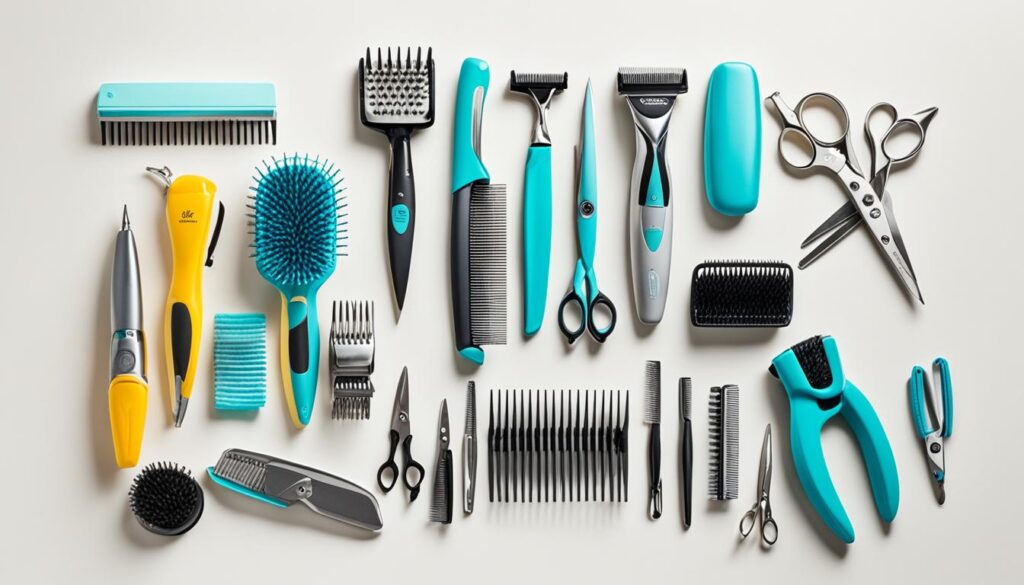
Step-by-Step Guide to Grooming Your Pet By Yourself
In this section, we will provide a step-by-step guide to grooming your pet by yourself. It’s a wonderful feeling to take care of your furry companion’s grooming needs at home. By learning the ins and outs of DIY pet grooming, you can ensure that your pet looks and feels their best, all while strengthening the bond between you.
Grooming your pet at home not only saves you time and money, but it also allows for a customized grooming experience that is tailored to your pet’s needs. Whether you have a dog or a cat, the grooming process can be both enjoyable and beneficial for both of you. Let’s dive into the key steps of DIY pet grooming:
Step 1: Brushing
Regular brushing is essential for maintaining a healthy and clean coat for your pet. Start by choosing the appropriate brush for your pet’s coat type. For example, slicker brushes work well for long-haired breeds, while rubber brushes are ideal for short-haired pets. Brush your pet’s coat gently, removing any tangles or mats. Remember to be patient and reward your pet with treats and praise for a positive grooming experience.
Step 2: Bathing
Bathing your pet helps keep their skin and coat clean and healthy. Before the bath, gather all the necessary supplies such as pet-friendly shampoo, towels, and a non-slip mat. Fill the bathtub with warm water and gently wet your pet’s coat. Apply the shampoo, lather it gently, and rinse thoroughly, making sure to avoid getting water in their ears and eyes. After bathing, towel-dry your pet and ensure they are warm and comfortable.
Step 3: Trimming
Trimming your pet’s hair is an important part of grooming, especially for breeds with long or fast-growing hair. Use specialized pet grooming scissors or clippers for a precise trim. Take it slow and steady, trimming small sections at a time. Pay attention to sensitive areas such as around the face, paws, and tail. It’s always a good idea to have treats nearby to reward your pet for their cooperation.
Step 4: Nail Clipping
Regular nail trimming is necessary to prevent overgrowth and discomfort for your pet. Choose a pair of pet nail clippers that suit your pet’s size and needs. Trim the nails in small increments, avoiding the quick (the sensitive part of the nail). If you’re unsure or uncomfortable with nail trimming, seek guidance from your veterinarian or a professional groomer.
Step 5: Finishing Touches
After completing the necessary grooming tasks, it’s time for the finishing touches. Use a pet-friendly brush or comb to smooth out the coat and remove any remaining loose hair. Check your pet’s ears for any signs of debris or infection, gently cleaning them with a veterinarian-recommended solution if necessary. Finally, reward your pet with praise, treats, and lots of love for a job well done!
Grooming your pet by yourself can be a rewarding experience and a great opportunity to bond with your furry friend. By following this step-by-step guide, you can ensure that your pet looks and feels their best. Remember to always prioritize your pet’s safety, comfort, and well-being during the grooming process.
Grooming Tips for Pets With Specific Coat Types
When it comes to grooming, different coat types require specific care to keep your furry friend looking and feeling their best. In this section, we will provide expert tips and techniques for grooming pets with various coat types, including long-haired breeds, short-haired pets, and curl-coated companions. By following these grooming tips, you can ensure that your pet’s coat remains healthy, shiny, and tangle-free.
Grooming Tips for Long-Haired Breeds
Long-haired breeds, such as Afghan Hounds, Golden Retrievers, and Yorkshire Terriers, require regular maintenance to prevent matting and keep their coats looking pristine. Here are some essential grooming tips for long-haired breeds:
- Brush your pet’s coat daily using a slicker brush or a comb with long, wide teeth. This helps remove tangles, prevent mats, and distribute natural oils throughout their fur.
- Trim the hair around their paws, ears, and tail to keep them clean and free from debris.
- Consider scheduling regular professional grooming appointments to keep their coat in top condition and to receive expert advice on breed-specific grooming techniques.
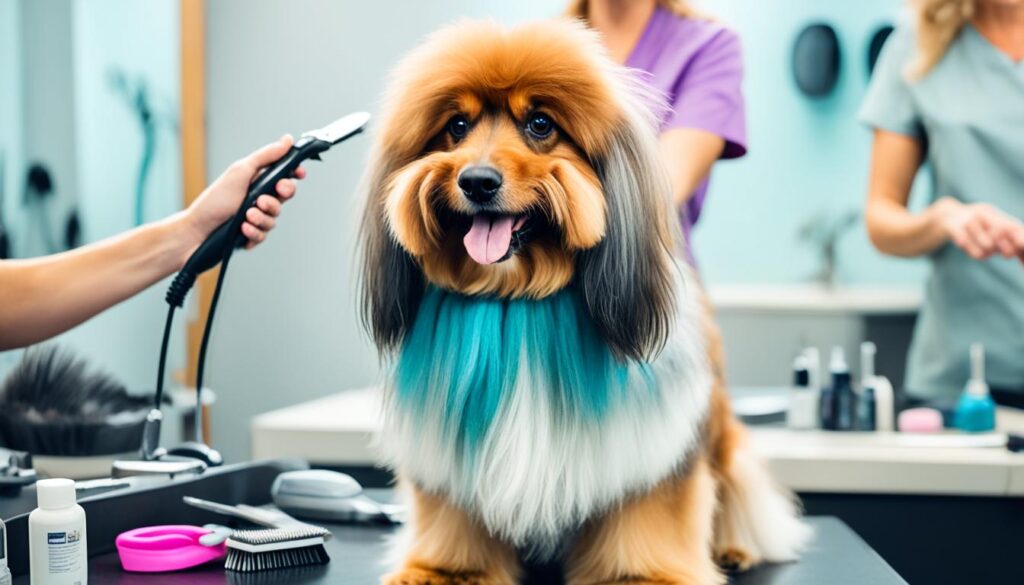
Maintenance Tips for Short-Haired Pets
Short-haired pets, such as Bulldogs, Dalmatians, and Siamese cats, may not require as much grooming as their long-haired counterparts, but they still benefit from regular maintenance. Here are some essential tips for grooming short-haired pets:
- Brush your pet’s coat weekly using a soft-bristle brush to remove loose fur and promote a healthy shine.
- Wipe their coat with a damp cloth or pet-friendly wipes to remove dirt and keep their coat clean.
- Trim their nails regularly to prevent discomfort and maintain their overall paw health.
Special Considerations for Curl-Coated Companions
Curl-coated companions, such as Poodles, Bichon Frisés, and Labradoodles, require specific grooming techniques to maintain their unique coat texture. Here are some special considerations for curl-coated companions:
- Brush your pet’s coat every other day to prevent matting and tangling. Use a comb with wide teeth or a slicker brush to gently separate the curls and remove any debris.
- Regularly schedule professional grooming appointments to maintain the proper length and shape of their curls.
- Consider using dog-friendly detangling sprays or leave-in conditioners to help manage their curls and keep their coat healthy and lustrous.
| Coat Type | Grooming Tips |
|---|---|
| Long-Haired Breeds | Brush daily, trim around paws/ears/tail, schedule professional grooming |
| Short-Haired Pets | Brush weekly, wipe with damp cloth, trim nails regularly |
| Curl-Coated Companions | Brush every other day, schedule professional grooming, use detangling sprays/conditioners |
DIY Pet Grooming Techniques: Bathing Your Pet
In this section, we will explore the DIY pet grooming technique of bathing your pet. Regular bathing is crucial for keeping your furry friend clean and healthy. Not only does it help remove dirt and odors, but it also promotes skin health and prevents common issues like fleas and ticks.
When it comes to bathing your pet, choosing the right shampoo is essential. Opt for products specifically formulated for pets, as human shampoos can be harsh on their sensitive skin. Look for gentle, hypoallergenic options that suit your pet’s specific needs. If your pet has any skin conditions or allergies, consult your veterinarian for suitable shampoo recommendations.
Now, let’s dive into the step-by-step process of bathing your pet at home:
- Start by preparing the bathing area. Place a rubber mat or towel in the tub or sink to prevent your pet from slipping.
- Fill the bathing area with lukewarm water. Ensure the water level is shallow enough for your pet to stand comfortably.
- Wet your pet’s coat thoroughly, starting from the neck down to the tail. Be cautious around their face, making sure to avoid their eyes and ears.
- Apply a small amount of pet shampoo to your hands and gently massage it into your pet’s coat, working up a lather. Pay extra attention to areas that tend to get dirtier, such as the paws and underbelly.
- Rinse your pet thoroughly with lukewarm water, ensuring all the shampoo is washed out. Soap residue can irritate their skin.
- Use a clean towel or a pet-friendly hairdryer on the lowest setting to dry your pet. Make sure to keep them warm throughout the drying process.
- Once your pet is dry, brush their coat to remove any tangles or mats.
For those looking for more natural and homemade grooming techniques, consider using alternatives to commercial shampoos. Ingredients like oatmeal, baking soda, and apple cider vinegar can be used to create gentle yet effective homemade pet shampoos. However, it’s important to do thorough research before trying any homemade grooming products to ensure they are safe for your pet’s specific needs.
Bathing your pet is an important part of their overall grooming routine. By following these DIY techniques, you can ensure a clean and healthy pet without the need for professional grooming services.
Pet Grooming Hacks for a Quick Fix
In this section, we will share some helpful pet grooming hacks for quick fixes. These hacks are designed to save you time and provide solutions to common grooming challenges, such as removing mats, freshening up your pet’s coat between baths, and dealing with minor grooming emergencies.
“A pet is an investment of time and love, so it’s important to have some grooming hacks up your sleeve.” – PetSmart
When it comes to removing mats from your pet’s fur, consider using a detangling spray or conditioning treatment to make the process easier. Apply the product to the mat and gently work it through with your fingers or a comb. This will help soften the mat and make it easier to untangle without causing discomfort to your pet.
To freshen up your pet’s coat between baths, you can use a dry shampoo specifically formulated for pets. Simply apply the dry shampoo to your pet’s fur, massage it in, and then brush it out thoroughly. This will help absorb excess oils and odors, leaving your pet’s coat looking and smelling fresher.
In case of minor grooming emergencies like a nick or cut while trimming your pet’s nails, you can use a styptic powder or a cornstarch paste to aid in clotting and stop any bleeding. Gently apply the powder or paste to the affected area, and apply slight pressure to help stop the bleeding.
Remember, these grooming hacks are meant to provide quick solutions, but it’s important to consult a professional groomer or veterinarian for any major grooming issues or concerns.
With these pet grooming hacks, you’ll be equipped to tackle common grooming challenges and keep your pet looking their best in between professional grooming sessions.
Addressing Common Challenges in Pet Grooming at Home
When it comes to grooming your pet at home, it’s not uncommon to encounter a few challenges along the way. But don’t worry, we’ve got you covered. In this section, we will discuss some common challenges that pet owners may face during the grooming process and provide valuable tips and strategies to help you overcome them. Whether you’re dealing with a nervous pet, managing common grooming injuries, or simply trying to keep your furry friend calm and comfortable, we have the solutions you need.
One of the most common challenges pet owners face is dealing with nervous pets. Some pets may become anxious or fearful during grooming, making the process difficult for both you and your pet. To address this, it’s important to create a calm and soothing environment. Play soft music or use calming pheromone sprays to help relax your pet. Take breaks if needed and reward your pet with treats and praise for good behavior. Gradually introduce grooming activities and be patient with your pet’s progress.
Another challenge that pet owners may encounter is the risk of common grooming injuries such as cuts, nicks, or accidents. To avert these injuries, it’s crucial to use the right grooming tools and techniques. Make sure you have sharp and well-maintained grooming tools to avoid accidental cuts. Take your time and be gentle when trimming or clipping your pet’s nails or fur. If you’re unsure about a particular grooming task, consider seeking guidance from a professional groomer or veterinarian.
Keeping your pet calm and comfortable during the grooming process is essential for a successful grooming session. Start by introducing your pet to grooming gradually, allowing them to become familiar with the process. Use positive reinforcement techniques to reward and encourage good behavior. Take breaks when needed and provide plenty of reassurance and affection to keep your pet at ease. It may also help to have a designated grooming area that your pet recognizes as a safe and relaxing space.
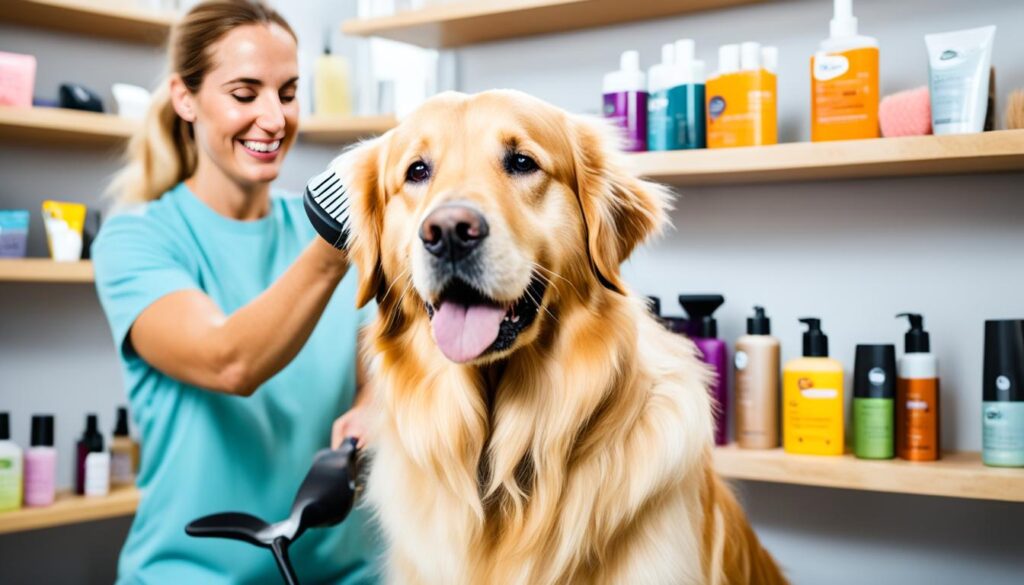
Grooming your pet at home can be a wonderful bonding experience, but it’s important to be prepared for the common challenges that may arise. By implementing these tips and strategies, you’ll be able to overcome nervousness, avert injuries, and keep your pet calm and content during grooming sessions. With patience, practice, and a little bit of extra care, you can ensure that your pet looks and feels their best, all in the comfort of your own home.
Easy Pet Grooming Techniques for Busy Owners
In this section, we will focus on easy pet grooming techniques for busy owners. We understand that not everyone has a lot of time to devote to grooming, so we will share time-saving tips and techniques that will help you efficiently groom your pet while juggling a busy schedule.
When it comes to grooming your pet, simplicity is key. Here are some DIY pet grooming ideas that will save you time and still keep your furry friend looking their best:
- Schedule regular grooming sessions: Set aside specific times each week to groom your pet. Having a routine will help you stay organized and ensure that grooming becomes a regular part of your schedule.
- Invest in the right tools: Having the proper grooming tools will make the process quicker and easier. Choose tools that are suitable for your pet’s coat type and invest in high-quality products that will last.
- Utilize self-grooming methods: Some pets are capable of self-grooming to a certain extent. Encourage your pet to groom themselves by providing self-grooming tools such as grooming wipes or self-grooming brushes. This will help keep them clean and reduce the need for frequent baths.
- Break it down: If you only have limited time for grooming, break down the process into smaller tasks. For example, you can focus on brushing one day, nail trimming another day, and bathing on a different day. This way, you can still ensure your pet’s grooming needs are met, even with a busy schedule.
Remember, taking care of your pet’s grooming needs doesn’t have to be complicated. By implementing these easy pet grooming techniques, you can keep your pet looking great while saving time and effort.
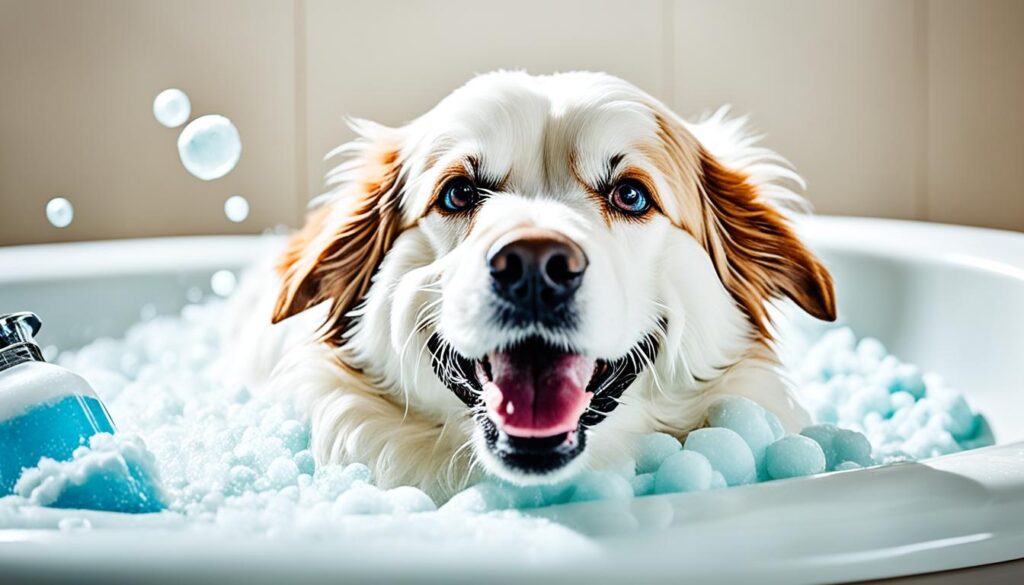
Conclusion
As we wrap up our article on DIY pet grooming, we want to highlight the significance of consistent and successful pet grooming techniques in keeping your furry friend looking great. By following the tips and strategies shared throughout this guide, you can ensure that your pet always maintains a healthy and well-groomed appearance.
Remember, regular grooming not only enhances your pet’s physical appearance but also promotes their overall well-being. By dedicating time and effort to grooming, you can prevent matting, skin irritations, and other common issues that can arise if neglected.
Additionally, between grooming sessions, there are simple strategies you can implement to keep your pet looking their best. Regularly brushing their coat, cleaning their ears, and trimming their nails are just a few examples of ongoing maintenance that can help maintain their grooming standards.
By embracing the DIY pet grooming techniques we’ve discussed and adopting a consistent grooming routine, you can ensure that your pet stays happy, healthy, and always looks their best. Whether it’s a simple brushing or a full grooming session, the effort you put into keeping your pet well-groomed will be rewarded with their undeniable charm and joyful companionship.
FAQ
What are some DIY pet grooming techniques I can try at home?
There are several DIY pet grooming techniques you can try at home, including brushing, trimming, nail clipping, and bathing. These techniques can help you maintain your pet’s appearance and overall health.
What supplies do I need for DIY pet grooming?
The essential DIY pet grooming supplies include brushes, combs, clippers, shampoos, conditioners, and nail clippers. These supplies will help you perform basic grooming tasks at home.
Can you provide a step-by-step guide to grooming my pet by myself?
Certainly! A step-by-step guide to grooming your pet by yourself would include brushing your pet’s fur, trimming any excess hair, bathing them, and clipping their nails. It’s important to follow proper techniques and ensure your pet’s safety during the grooming process.
Are there any specific grooming tips for pets with different coat types?
Yes, each coat type requires specific grooming techniques. For long-haired breeds, regular brushing and detangling are necessary. Short-haired pets benefit from regular brushing to remove loose hair. Curl-coated companions require careful maintenance to prevent matting and tangles.
How can I properly bathe my pet at home?
To properly bathe your pet at home, start by selecting a suitable shampoo and filling a tub with warm water. Wet your pet’s fur and apply shampoo, massaging it into their coat. Rinse thoroughly and dry your pet with a towel. Homemade pet grooming techniques can also be used to create natural and gentle bathing experiences.
What are some pet grooming hacks for quick fixes?
Pet grooming hacks can include removing mats with cornstarch or baby powder, freshening up your pet’s coat between baths with dry shampoo, and addressing minor grooming emergencies such as trimming a nail that has been cut too short. These hacks can save you time and provide solutions to common grooming challenges.
How can I address common challenges when grooming my pet at home?
Common challenges when grooming your pet at home include nervousness, injuries, and maintaining their calmness during the grooming process. Strategies like introducing grooming slowly, using positive reinforcement, and keeping grooming sessions short can help overcome these challenges.
What are some easy pet grooming techniques for busy owners?
For busy owners, it’s important to find time-saving techniques for pet grooming. Some easy techniques include using grooming wipes between baths, scheduling regular grooming sessions, and incorporating grooming into your daily routine.

